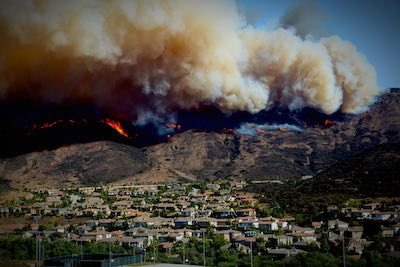Better weather forecasting, enhanced emergency preparation, and heightened public awareness of hurricanes and how to survive them appear to have contributed to a much stronger response to Hurricane Harvey than to the twin disasters of Katrina and Rita more than a decade ago, said an expert from Georgetown University.
“We’ll know more in a few weeks, but on the surface it appears to be a much better response than what we saw with Hurricane Katrina,” said Tim Frazier, faculty director of the University’s Master's in Emergency & Disaster Management program.
Frazier also said that the decision not to evacuate Houston—while criticized by some—was the right one.
“You can’t move six and a half million people [roughly the population of Houston area] in the time needed to move them,” Frazier said.
A More Informed Public
In 2005, the partial evacuation of much of Houston and surrounding areas in advance of Hurricane Rita resulted in clogged highways, and many people died from traffic accidents and complications from the extreme heat. According to the Texas Tribune, of the 139 deaths in Texas linked to Rita, 73 occurred before the hurricane hit the state.
Advances in data analytics have resulted in more accurate storm tracking and precipitation estimates. Frazier said that Harvey’s record rainfall, which totaled 50 inches in some places, was in line with what forecasters predicted. This data, combined with more sophisticated topographical information and other data, has allowed forecasters to pinpoint where flooding might occur.
Unlike in years past, when the public mostly relied on civil defense information to prepare for storms, people today have multiple news sources, Frazier said. This can be problematic when they act on sketchy information; but it can be beneficial when they use the news in proactive ways, such as when ordinary citizens—the “Cajun Navy”—performed countless water rescues and evacuations.
Stronger Storms
But while rescue workers and the public are in a better position to respond to these events, the storms themselves are getting stronger and the population centers they threaten bigger and more densely populated.
It is difficult to link any one storm and its level of ferocity with climate change, but scientists say the trend is toward more extreme weather events, caused, in part, by warmer sea and atmospheric conditions. In normal times, there is a rough balance between the frequency of storms and their magnitude; that is, the stronger a storm, the less likely it will occur. Now, this relationship seems to be changing.
“What appears to be happening with climate change is a disruption of the frequency/magnitude equation,” Frazier said. “So what we’re likely to see in the future is more frequent, high-magnitude events.”
To cite one example, Hurricane Harvey is the third “500-year” flood to hit the Houston region since 2015; and some scientists are calling it a “1,000-year” flood.
Every year, as metro areas grow, there is the potential for more people to be affected. In 2015, according to the U.S. Census, Houston led the nation’s metro areas in population growth, adding about 159,000 people—and all the streets, parking lots, and other impermeable surfaces that go with them.
When a hurricane does strike, as it did with Harvey and its unprecedented flooding, rescue workers have to make tough choices and be able to think on the fly. That means triaging multiple emergencies and taking the most pressing ones first.
“The very definition of a disaster is an event that overwhelms the local community’s capacity to respond,” Frazier said. And, as a result, “sometimes, you have to respond to the person who is most in need—when everyone is in need.”
